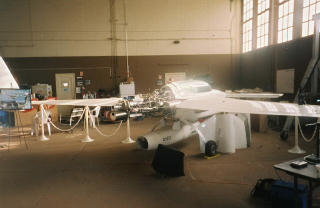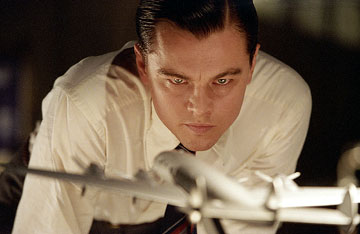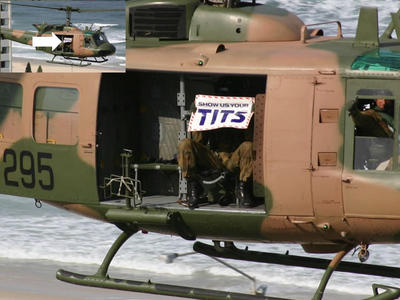We are developing the social individualist meta-context for the future. From the very serious to the extremely frivolous... lets see what is on the mind of the Samizdata people.
Samizdata, derived from Samizdat /n. - a system of clandestine publication of banned literature in the USSR [Russ.,= self-publishing house]
|
Whatever you reckon on the politics of it all, it is still a big (and I do mean big) step (jump?) forward for aviation. I refer to the maiden flight of the gigantic Airbus A380, which has just been successfully completed.
The A380 – designed to carry as many as 840 people between major airports – took off from its production site in southern France at just after 0830 GMT.
“The speed on take-off was exactly as we had expected,” said test pilot Jacques Rosay.
“The weather is wonderful. Everything is absolutely perfect and we are very happy.”
The crew took the plane out over the Bay of Biscay, before returning to base.
This, though, the Antonov An-225, featured last Monday evening on C5 TV’s Massive Machines show, is even bigger.
Airbus will not mind about that, but they may be more worried about this:
WASHINGTON – Buoyed by an influx of new orders, Boeing Co. appears to be turning the corner in its battle with archrival Airbus.
So, will all this airplane competition make global warming worse, to the point of eventual global disaster? My sister goes on about the globally warming badness of jet airplanes is every time I meet her.
I must remember to ask my nephew, her son, what he thinks about this issue, next time I meet him. He is an airline pilot.
According to The Australian, Richard Branson wants an Australian site for his new suborbital space planes. That in itself would not be particularly unusual: others before him have seen and considered the Australian launch advantage.
A final design for Virgin’s flagship spacecraft, the VSS Enterprise, is expected to be signed off on this year. A US base is expected to be training 3000 astronauts for the $US190,000 sub-orbital flights in as little as three years.
Sir Richard said in Sydney that the plan was to build sufficient spaceships to allow the establishment of separate bases around the world.
It may not have done so for many of you, but this sets off tinkling bells and flashing lights for me. If you are at all close to the space industry you will know there is an excellent near equator site in Australia where there has long been interest for a Spaceport. I have not been following it much lately, but I do remember there was an intent to launch Russian rockets from there. The current status is neither here nor there: Australia is the only Anglospherian country with existing space infrastructure and near equatorial lands.
When a spaceship takes off it gets an extra boost from the Earth’s rotational velocity. The further from the equator you are, the less advantage you get. Imagine you were at the North Pole. The Earth is rotating your spaceship on the pad once every 24 hours and when you launch, your engines have to supply 100% of the velocity required for orbit.
If you are at an intermediate geographical location, like KSC at Cape Canaveral, the rotating planet is moving your spaceship at a significant eastward velocity before it even leaves the ground.
If you are at the equator, you are already traveling at a rate of 1/24 the Earth’s circumference per hour. An equatorial or near-equatorial site is ideal for a first generation orbital spaceship . It gives a starting velocity of a little under a half km/sec eastwards on your fully loaded spaceship before it even leaves the ground. This is a big win. You need roughly 7.5 km/sec to make orbit: you may think of the Earth’s equator as a free, reuseable first stage.
So. Inference one: Branson is already looking ahead to orbital flights.
Now notice he is considering more than one spaceport location. He is not talking of abandoning the US launch site in the Mojave. He wants to add another site for suborbital fares. He would have two sites at which he could operate suborbital space ship take offs and landings.
Branson is in the airline business and knows better than I what the size of the market is for people who want to take a short suborbital tourist hop… versus the number of high value business people who would pay extraordinary fares to reach the antipodes in 45 minutes. British Air refused to sell him the Concordes, but Richard might just laugh last and best.
Inference two: I expect we will at some point see a proof of concept flight of a Rutan vehicle which leaves the Mojave on a suborbital intercontinental ballistic trajectory and lands in Australia. If he has a vehicle capable of carrying 6 paying passengers for tourism, that same vehicle with a lone pilot can probably boost onto a trans-Pacific trajectory.
Branson, Rutan and Allen are smart cookies. They are not going to advertise their plans ahead of time. But if you are going to go into space and make it pay, this is the way to do it:
Step 1) Fund a suborbital test vehicle and get it partly paid for by winning the X-Prize. [DONE]
Step 2) Build a suborbital joy ride vehicle that mostly pays for itself going up and down. [IN PROGRESS]
Step 3) Fly the first intercontinental suborbital flight with that vehicle in a stripped down single pilot mode.
Step 4) Build a slightly larger vehicle that mostly pays for itself via trans-Pacific flights.
Step 5) Use that American built vehicle in a stripped down, single pilot mode to fly from an equatorial base into orbit. Perhaps it will be necessary to build a special vehicle to deal with higher re-entry heat loading, but there are now two revenue streams on line, not to mention Bob Bigelow’s $50M America’s Space Prize.
Step 6) Add another revenue stream. Sell astronaut transport services to NASA about the time the Shuttles are sent off to museums. Perhaps also sell delivery services to Bob Bigelow’s inflatable orbital facility for yet another stream.
Step 7) Earth orbit is “half way to anywhere”. The solar system is now your oyster.
As they say in the tech business, “It’s a plan!”
This NASA PSA works on so many levels I hardly know where to begin.
It does not at any point say “only socialist space programs can get us there”. You could infer that if you saw it in certain contexts, but then again, if you saw it at a space entrepreneurs get together you would not. The underlying message is a good one and I thoroughly applaud it. We will reach for the stars. We will colonize the solar system. We will leave the cradle.
The infant is a young Paul Allen or Bob Bigelow or Burt Rutan… not a future employee of the State.
Ed: You may need to down load the mpg and play it locally.
by Rick Tumlinson
Rick Tumlinson of the Space Frontier Foundation is an old friend of mine who has been directly involved in much behind the scenes in commercial space, including the private attempt to save MIR. Here, with his permission, is an article like the one I have been intending to write. I am still traveling and just have had no time do so. Rick probably did a better job of it anyway
There are three initiatives from 2004 that if built upon the right way will rapidly accelerate the human breakout into space.
The first was U.S. President George W. Bush???s vision of permanent human presence beyond Earth orbit, which was endorsed by congressional funding and clarified by the Aldridge Commission.
The second was the flight of SpaceShipOne, the first major triumph of the new space movement and its goal of opening space to the people. This was solidified by a multi-million-dollar contract from Virgin Galactic to build a fleet of commercial spaceships.
Finally, the passage of legislation in Congress that begins to create regulatory certainty in the New Space transportation field clears the way for the long-term development of this nascent industry.
→ Continue reading: Private Industry Can Help NASA Open the Space Frontier
There are a lot of big shiny 1940s-era aircraft zooming across our cinema screens at the moment. Yeh! We have had Sky Captain and the World of Tomorrow, we are due to get the remake of The Flight of Phoenix, based on the wonderful old movie starring James Stewart, and I have just returned from watching The Aviator, starring Leonardo Di Caprio as mogul, test pilot and eccentric, Howard Hughes. It is a fine film, and makes a number of important points about the man himself, the nature of doing business in America in the mid-20th Century and the evolution of modern air travel.
The story is quite well known of how a rich young oil family son becomes a major player in the aviation industry, challenges rivals like PanAm, produces smash-hit movies, before descending into madness and solitude. Director Martin Scorcese has long been fascinated with Hughes’ tale and gets DiCaprio to convey the mixture of driving ambition, brilliant engineering skills, bravery and craziness. Hughes could be seen, from one vantage point as an almost Randian-style business hero, challenging rivals like PanAm, whose boss was played with appropriate menacing charm by Alec Baldwin.
There are two great scenes which get the pro-enterprise, unpretentious side of Hughes across. He drives with his then girlfriend, Katherine Hepburn, excellently played by Cate Blanchett, to see Hepburn’s family. At lunch, Hepburn’s mother, instantly declares to Hughes that “we are all socialists here”, and “I do hope you are not a Republican”, and Hughes, bless him, looking around the vast mansion and its grounds, is too dumbstruck at these comments to make a fast and smart reply. Recovering his composure, later Hughes tells the preening Hepburns that his favourite reading is technical engineering reports on planes, which of course has the welcome effect of shutting the ghastly Hepburns up.
In a later scene, set in 1947 when Hughes is fighting for the future of his airline TWA against the monopolistic ambitions PanAm in cahoots with the U.S. Senate, Hughes makes a number of fine points about competition and business risk-taking that almost got me cheering in the stalls. Hughes wins his battle and PanAm is forced to concede.
Hughes was a troubled man and spent the last two decades of his life in circumstances so lonely and depressed that it of course will colour one’s view of his life in the round. But I came away from the film feeling a certain admiration for Hughes in how he was willing to challenge the status quo. Long after people have forgotten corrupt U.S. senators and complacent airline bosses, they will remember the man who built and flew some amazing planes. I also cannot help but wonder whether people will think something similar in future about our contemporary airline boss and daredevil man of action, Britain’s own Richard Branson. We shall see.
The picture below has been making the rounds of the net aviation (and other) communities the last few days. The young Aussie lads chanced upon a motor race event whilst on coastal patrol. They went into a temporary hover all the better to communicate with numerous and luvly birds on the ground.
Someone caught them in the act and the photo went up on a professional pilot’s site from whence it spread to other places.
The lads seem to be in a bit of hot water over it, no doubt due to complaints from the PC (Pulchritudinously Challenged) sector.
Lt. Charlie William of the British Army survived a 3500 foot fall with minimal damage to his person after his parachute rigging tangled upon exit from the airplane during training over Kenya.
He broke through a corrugated iron roof and gave some Kenyans a bit of a start. I have heard of dropping in for tea unexpectedly, but Charlie seems to have taken it a bit farther than most.
It does not appear to have been reported whether the home owners supplied their guest with a hot cuppa as he awaited assistance.
Since Brian brought the subject up… I too have been following the political posturing that has been going on about regulating the nascent human space flight industry. The regime that currently exists is quite satisfactory to all. Customers have to read a list of all the horrible ways in which they will probably die, but once they have done so the FAA will get out of the way so long as the launch company guarantees the body parts will not cause more damage than the insurance covers when they hit the ground. (It is a little more complex than that, but I am not about to give a tutorial on spaceflight FARS just now.)
I think this open letter from an old friend of mine will explain what is currently going on in DC, or at least give you an intro to it.
Friday, November 19, 2004
Dear Space Advocates & Correspondents:
This afternoon the House of Representatives had a 40 minute debate on legislation designed to advance the U.S. commercial human spaceflight industry. It was a good and spirited debate, with bipartisan supporters speaking in favor, and two partisan Democrats speaking against HR5382.
Unfortunately, the opponents’ arguments reflected the same misunderstanding of this issue that so many people have. Their presumption is that the federal government needs to set standards to protect the safety of the early adventurers who wish to buy a risky ride into space. Even before the vehicles that would fly them are designed, let alone built and flying. Frankly, Mr. Oberstar and Mr. DeFazio, the Ranking Minority Members of the House Transportation & Infrastructure Committee and its Aviation Subcommittee, seem to believe that we need to regulate spaceflight as if it were just another approach to Aviation.
But rockets are not airplanes, and the Commercial Space Launch Act and the U.S. commercial space transportation industry are not under the jurisdiction of the Aviation Subcommittee. Space is a new sphere of economic activity, and the House’s experts on these issues are members of the House’s Committee that is focused on America’s future, the Science Committee.
More importantly, the House worked for several months with the Senate to develop a compromise version of the original HR3752, which was passed by a vote of 402 to 1 in March of this year. It is important to note that HR3752 told the Secretary of Transportation to promote and license the carrying of “space flight participants” for compensation, i.e. to make money, under an “informed consent” regime. In other words, the rocket company had to tell the passenger how likely it was they might crash, and then the passenger could choose to take the risk or not. All regulation was focused on making sure the rockets didn’t hurt anyone on the ground. The Secretary was not given any authority – and has none under current law – to regulate in order to protect people riding on the vehicle.
And I might just point out, Mr. Oberstar and Mr. DeFazio both voted for HR3752 in March, along with every other Democratic member of the Transportation Committee who showed up to vote. (The only vote against HR3752 in March was by a libertarian Republican who didn’t think the government had any right to regulate rockets at all !)
So today’s choice on HR5382 is a choice not between one level of safety and another. It’s between Congress telling the American people they have a right to go into space and an expectation that, over time, it will become more affordable and more reliable to do so… and saying “we can’t be bothered to write legislation to help enable this new industry”. Fortunately, the American people *already* have the right to go into space. And the American free market will make it ever-more-affordable and ever-safer, even without the help of federal regulators. But it would be a good thing if this bipartisan legislation were enacted into law to help accelerate the process.
Ironically, the two members speaking in favor of higher safety today will actually leave the industry free to do whatever it wants under current law, with no process by which the Secretary could, let alone would, start to set safety standards. So perhaps they are more committed to stopping legislation – and a new industry – than safety, after all.
James Muncy
Consultant to several Commercial Human Spaceflight companies
I am sure some will complain the government should not regulate space industry at all. I agree. Unfortuneately that option does not exist. We can either ameliorate what government is going to do and have a space industry, or close our eyes and let the worst sort of Nanny Statists have their way. That could kill the industry before it grows big enough to defend itself. That is to say, big enough to get your and my bottoms off this dirtball.
XCOR Aerospace, the Mojave spaceship company which provided floor space and food for many of us who attended the first commercial suborbital launch in June, has announced a contest.
The prizes will be given to the persons, groups or companies who provide working steam engines fulfilling the contest specifications at various levels.
Yes, spaceships really can use steam engines. There is a lot of waste heat floating around a rocket engine so it makes sense to use some of it to operate the engine. If you are a home machinest or have a small engineering company and think this might be fun, go pick up the rules and the pump interfaces specification.
Ad astra my friends!
 Photo: copyright Dale Amon, all rights reserved
Photo: copyright Dale Amon, all rights reserved
I just ran across this quote of Burt Rutan from this afternoon on Space Flight Now:
“Quite frankly, I think the big guys, the Boeings, the Lockheeds, the nay-say people at Houston, they probably … think we’re a bunch of home builders who put a rocket in a Long Easy,” he said, referring to one of his recreational aircraft designs. “But if they … got a look at how this flight was run and how we developed the capabilities of this ship and showed its safety, I think they’re looking at each other now and saying, ‘We’re screwed.'”
Yes, I do believe the pigs had their noses so deep in the trough they never saw the hatchet coming. If any of them did look up they just grunted at the idea anyone could possibly ever displace them, not realizing they were not being so much displaced as bypassed and made redundant to requirements.
I love the smell of bacon in the morning. It smells of… liberty.
I am sure the Scaled Composites team is busy with their last minute checkouts now. I will be following this event as closely as one can from a third of a planetary circumference away. Obviously I will not be as immediate as those on the edge of the runway, but perhaps I can supply knowledgeable commentary on the next few hours.
So, time to get the Anseri X-Prize out of the way and move on to the Bigelow et al Prize!
Time to up-ship! Hot jets, good luck and Godspeed Mike!
UPDATE: The pilot for this flight has been announced and will be Brian Binnie.
UPDATE 1257 UTC: Weather at Mojave is reported looking good. Which is not unusual for Mojave! White Knight/SpaceShipOne takeoff is scheduled for 1400 UTC, so I would imagine they are outside the hanger and doing the the Pre-Flight about now. Burt Rutan has reportedly stated they are shooting for the alitutude record today, 354,200 feet reached by Joe Walker in the X-15 on August 23, 1963.
UPDATE 1317 UTC: As Rand Simberg points out, today is the 47th Anniversary of the first satellite launch.
UPDATE 1339 UTC: WK/SS1 is reported to be on the taxiway. I imagine the crowds are waving flags and going wild about now. Not much longer before the takeoff… then we wait an hour for the drop and burn.
UPDATE 1356 UTC: WK/SSI is in the air. For the next hour everyone gets a sore neck watching them circle ever higher towards the 47.000 foot drop altitude. It gets a bit easier to follow them when they pass about 20,000 feet and contrails begin to show… of course that depends on the conditions at altitude and is not a given. Then they will fly to the East of the airport so they will be nearer Edward AFB for radar tracking. This means everyone gets absolutely blinded looking into the sun to watch the initial climbout after the drop an hour from now.
UPDATE 1425 UTC: If you were watching Black Sky on Discovery last night (obviously I did not, sitting here outside Belfast) and liked the simulations of the SS1 flight, you can buy the software at X-Plane. Tell Austin I sent you.
UPDATE 1431 UTC: I expect WK/SS1 is passing through 40,000 feet about now. I notice that an old friend of mine, Greg Maryniak, is the commentator for the X-Prize Foundation. Not that surprising since Greg and Peter Diamandes, who I’ve known since he and the late Tod Hawley were MIT college kids, run the place. Greg was the Exec at the Space Studies Institute in Princeton all through the 1980’s and into the early 1990’s.
UPDATE 1445 UTC: By the time you read this I expect SS1 will have dropped and fired the hybrid rocket motor. Yeehah!!!
UPDATE 1452 UTC: Drop and burn happened on time… burnout and SS1 is coasting upwards, hopefully to break the X15 record as well as cop the $10,000,000 Anseri X-Prize!
UPDATE 1455 UTC: Unofficial apogee at around 368,000 feet. They may have the record. X-15 max was 354,200 feet. Sounds like a safe margin to me!
UPDATE 1515 UTC: Verily as I was on the phone trading notes with Rand, it touched down. The X-Prize has been won! The X-15 altitude record has been bettered! Now, on to commercial Virgin Galactic flights, on to the Bigelow prize for an orbital flight by 2008… and not to mention we can expect the da Vinci project to carry out their balloon drop flight within a few months and Armadillo Aerospace should fly sometime next year too. Oh what a wonderful year this is!
UPDATE 1619 UTC: It seems the altitude is official and Burt is claiming the altitude record. In an article I wrote last year, I suggested Rutan has a shot at ‘the Triple Crown’ of aviation records. Voyager flew around the world non-stop for the distance record; SS1 has now copped the altitude record. The only gem missing from the Scaled Composites front office is speed. As many have pointed out, SS1 is probably not capable of surviving a low angle speed run. But that does not mean some near future Rutan vehicle will not do it. I think he will go for it at some point.
UPDATE 1654 UTC: I note that Leonard David has been the journalist blogging for space.com from Mojave. Len is another one of our little crowd of space illuminati. He started off with the Project Harvest Moon attempt to buy the last Saturn V’s back in 1976 or so; he founded a space organization of his own at university and later became the magazine editor for for Von Braun’s NSI, and later for Ad Astra of NSS, the merged L5 and NSI organization. He also plays a mean autoharp. Yep. We all know each other.
I just received this Burt Rutan statement in my ‘in-basket’. It addresses the much media hyped rolls, which were in reality not a very big deal:
While observing the significant incorrect information being published about the rolls seen on the 29 Sept 04 SpaceShipOne flight, we are responding by offering a bit of discussion to help provide some clarity. This information is approved for publication — Burt Rutan
Comments On The Rolling Rumors
Burt provides some preliminary information about the rolling motions seen on the First X-Prize Flight:
The complex reason on why the rolling departure occurred will be described in a report we will post at a later date. What I am intending to do here is merely address some of the incorrect rumors about the rolls that have been seen in various news stories and web discussion groups.
While the first roll occurred at a high true speed, about 2.7 Mach, the aerodynamic loads were quite low (120 KEAS) and were decreasing rapidly, so the ship never saw any significant structural stresses. The reason that there were so many rolls was because shortly after they started, Mike was approaching the extremities of the atmosphere. Nearly all of the 29 rolls that followed the initial departure were basically at near-zero-q, thus they were a continuous rolling motion without aerodynamic damping, rather than the airplane-like aerodynamic rolls seen by an aerobatic airplane. In other words, they were more like space flight than they were like airplane flight. Thus, Mike could not damp the motions with his aerodynamic flight controls.
Mike elected to wait until he feathered the boom-tail in space, before using the reaction control system thrusters (RCS) to damp the roll rate. When he finally started to damp the rates he did so successfully and promptly. The RCS damping, to a stable attitude without significant angular rates was complete well before the ship reached apogee (337,600 feet, or 103 Km). That gave mike time to relax, note his peak altitude, and then pick up a digital high-resolution camera and take some great photos out the windows. Those photos are now being considered for publication by a major magazine.
While we did not plan the rolls, we did get valuable engineering data on how well our RCS system works in space to damp high angular rates. We also got a further evaluation of our “Care-free Reentry” capability, under a challenging test condition. As seen on the videos of the flight, the ship righted itself quickly and accurately without pilot input as it fell straight into the atmosphere. No other winged, horizontal-landing spaceship (X-15, Buran, SpaceShuttle) has this capability.
Incidentally… there will be quite an all night party at Mojave Civilian Test Flight Facility (and Spaceport) the night before the second flight. Apogee Books is sponsoring an all night music fest near their tent in the public viewing area.
Sadly I will again not be there.
Addendum: For the non-pilot readers, KEAS is Knots Equivalent Airspeed. Knots are Nautical Miles per Hour in pilotese. To place this in perspective, my old Cessna 172, (N3892S circa 1981), was quite happy cruising along at 120 KIAS, or 120 Knots Indicated Airspeed. Airspeed is how fast the wind is going past your wings. If you were in a 120 Knot headwind, you could be flying 120 KIAS and sitting over someone’s head like you were the ball on top of a flagpole. Indicated means it is what you read off the dial in the cockpit; Equivalent means that the air over your wings has the equivalent effect after accounting for speed and density of the air. (You can also play with a thing called a Reynolds number which affects basic design of aircraft in various regimes, here if you are interested.)
|
Who Are We? The Samizdata people are a bunch of sinister and heavily armed globalist illuminati who seek to infect the entire world with the values of personal liberty and several property. Amongst our many crimes is a sense of humour and the intermittent use of British spelling.
We are also a varied group made up of social individualists, classical liberals, whigs, libertarians, extropians, futurists, ‘Porcupines’, Karl Popper fetishists, recovering neo-conservatives, crazed Ayn Rand worshipers, over-caffeinated Virginia Postrel devotees, witty Frédéric Bastiat wannabes, cypherpunks, minarchists, kritarchists and wild-eyed anarcho-capitalists from Britain, North America, Australia and Europe.
|








